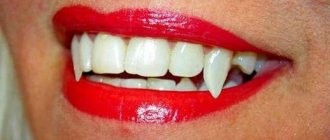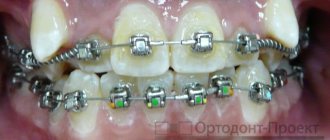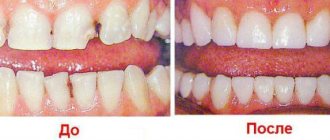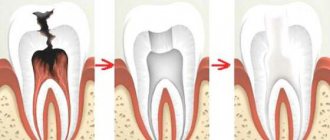Some people use the services of a dentist to change their appearance. The procedure for extending fangs is popular. Adding fangs to healthy teeth allows you to create a vampire look. Before extensions, you should familiarize yourself with the contraindications and possible consequences. You should first weigh all the pros and cons.
Why canine extensions are performed, indications
Any adult has four fangs in his mouth - two at the top and two at the bottom. Visually, they are practically no different from other teeth. Some young people, fans of mysticism and the aesthetics of vampirism, turn to the dentist for fang extensions. The procedure allows them to bring their image closer to that of a vampire.
There are also certain medical indications for canine extensions. Only a dentist can prescribe such extensions. The technique is safe and can be performed by almost anyone. There are several ways to lengthen teeth, in most cases the direct method is used. The length of the extended tooth should not exceed 4 mm. It should be taken into account that an elongated tooth in the mouth can create discomfort and there is a risk of injury to the mucous membrane.
Indications for the procedure:
- therapy - extensions are carried out in case of chips or damage to the crown;
- aesthetic goal - whether there is a need to change the size or shape of the tooth;
- orthopedics - extension is carried out when a tooth is completely destroyed and needs to be restored.
The choice of augmentation technique depends on the indications.
"Real blood"
In the TV series True Blood, the placement of the fangs was taken as freely as in Nosferatu. Yes, there are two fangs, but they grow from the lateral incisors, and this haunts many fans of the series who insist on preserving the canonical vampire image. The creators of the series explained their choice by the fact that in such a place the fangs are much more visible to the audience, and the actors themselves do not have to open their mouths too wide. Plus it looks fresh and more aggressive.
Still from the TV series “True Blood”. Courtesy photo
Advantages and disadvantages
Fang extensions have certain advantages and disadvantages. Advantages of the technique:
- aesthetics;
- durability;
- the possibility of full restoration - restored fangs become natural;
- no load on neighboring teeth;
- the ability to choose a shade;
- painlessness - there are no discomfort during canine extensions;
- the opportunity to change the image.
Flaws:
- high price - often due to the need for additional procedures;
- the possibility of redistributing the load during chewing, which will lead to damage to other teeth;
- risk of injury to the oral cavity due to a canine broken during chewing;
- unpredictability of expectations from the procedure - some patients are pleased with their fangs for a short period of time;
- impossibility of tooth extension in the presence of a partially damaged root.
"Real Ghouls"
“Real Ghouls” is a reality TV series from Taika Waititi, which received so many “Hilarious!” ratings that you can forget about its scary component. This is the story of ancient vampires (the youngest of them is 183 years old) who live in modern New Zealand, watch the sunrise on YouTube without the risk of being killed by sunlight and comically hiss like angry cats. When creating his vampires, Waititi turned to traditional techniques - three of them have fangs like Dracula, and Peter, who lives in the basement, became an allusion to Count Orlok with fangs sticking out in all directions.
Still from the film "Real Ghouls". Courtesy photo
Contraindications
Fang extensions are not recommended in the following cases:
- severe abrasion of tooth enamel;
- signs of periodontitis;
- defects in the root region;
- malocclusion - shifting the load during chewing can lead to excess pressure on individual elements;
- failure to comply with oral hygiene rules;
- allergic reactions to materials used in extensions.
Ignoring contraindications can lead to serious damage to the chewing teeth. Before the procedure, it is recommended to eliminate all of the listed defects.
Preparation
Extension of fangs requires preliminary preparation. Preparatory procedures are divided into preliminary (optional) and immediate (mandatory).
Preparation may include the following procedures:
- Professional cleaning of tartar, plaque and dirt. The procedure allows you to set the actual shade of enamel for choosing a material. The specialist must take into account the different colors of the base and edges of the tooth.
- Treatment of caries is a mandatory procedure.
- Taking impressions allows you to determine the best tooth shape.
- Canine preparation is carried out before applying the composite material. The procedure ensures tight fixation of the composite on the tissue. The part being built up will receive additional thickness.
- Grinding of hard tissues - allows you to give the tooth a natural shape. Care is taken during the procedure to avoid damage to the internal layers and eliminate pigmented areas of dentin.
Extension methods
There are several ways to grow fangs in dentistry. The choice depends on the condition of the teeth, clinical picture, and patient preferences.
Direct method
The direct method of extension is the most gentle. All manipulations are carried out directly in the patient’s oral cavity. The composite material is applied to the teeth in layers. The final stage is grinding and polishing. The selection of parameters is carried out taking into account the characteristics of the dentofacial apparatus. The procedure is similar to nail extensions. The duration of the procedure does not exceed 2 hours. It is worth noting that fangs grown with reflective material do not darken over time and are compatible with living tissues. Stages of extension:
- turning of hard tissues - the procedure allows you to create the shape of a fang;
- surface insulation - latex fabric with a hole for the fang will help prevent moisture from entering;
- enamel conditioning - increases the adhesion strength of composites to the tooth;
- application of adhesive systems - ensures a strong connection of composite materials with dentin.
- layer-by-layer application of the composite - it all depends on the desired shape and degree of tooth destruction;
- grinding and polishing;
- highlighting - the procedure accelerates the hardening process of the composite.
When using composite materials for restoration, you should be aware of certain features of the technique. The degree of porosity may exceed the porosity of tooth enamel. This requires two precautions. First of all, for several days after the procedure, you should avoid eating foods and drinks with coloring components in their composition. The second mandatory condition is professional hygiene twice a year. Thorough polishing will help preserve the original shade of the fangs.
Veneers
Veneers are ultra-thin overlays that are attached to the teeth from the front. Their thickness is 0.5 mm. Overlays allow you to correct darkened enamel, defects, chips, diastemas, cracks. After their installation, the teeth take on the desired shape. The procedure is carried out after grinding down the enamel layer, thereby ensuring strong adhesion. Veneers are either composite or laboratory-made. The service life of the plates reaches 101-5 years. Stages:
- grinding down the enamel - a specialist applies special grooves to fix the onlays on the teeth;
- preparation of casts;
- installation of temporary plastic overlays;
- installation of permanent veneers using cement.
Composite veneers are created in one session in the dental chair. The material is applied in layers. The second method is less durable; such veneers require regular polishing.
Lumineers
Lumineers are ultra-thin overlays. Their installation does not require preliminary preparation of the tooth. Dental porcelain with minerals is used in the manufacture of plates. Overlays allow you to hide color defects and blemishes. And it can be removed, no need to grind off the enamel. The installation procedure only takes a couple of procedures. At the first visit, the patient is examined, the dentist listens to the patient’s wishes and offers options. The impression taken is sent to the laboratory. Next time, the doctor installs ready-made lumineers on a previously cleaned tooth.
Stump tab
Fang augmentation is also carried out in case of a damaged tooth. When restoring a tooth that has broken away from the base, it is recommended to use a core inlay. Metal alloys, zirconium dioxide, ceramics, and plastic are used in manufacturing. Ceramics and zirconium have excellent characteristics. They look great, are durable, and do not destroy surrounding tissue. When making core inlays, individual parameters are taken into account; everything depends on the shape of the tooth being restored. The dimensions should not exceed the size of the teeth; a composite is applied on top or a crown is fixed. The recovery procedure takes up to a month. Stages of installing the stump tab:
- removal of damaged tissue, expansion of channels;
- taking an impression for the inlay;
- installation of the structure using dental glue;
- creating a layout for the crown;
- fitting, choice of color for crowns;
- coating application;
- fixation of the finished crown.
Artificial crowns
Prosthetics is the most radical method. The patient should be warned that there is no reversal after the crowns are installed. The method is labor-intensive; extensive tissue preparation is first carried out. Artificial crowns are made taking into account the characteristics of the dental system. Crowns can be installed on ground teeth, pins, stump inlays. Stages of making fangs:
- At the initial stage, an impression is made. Based on this, a specialist works in laboratory conditions to create a fang. Gypsum is used as a test material.
- Trying on, adjusting the layout, sending the cast for revision if necessary.
- Installation of a temporary structure for 2 weeks.
- Choice of material - the artificial tooth is made of zirconium dioxide, metal ceramics. The first option is in great demand due to its strength, wear resistance, and aesthetics.
- Making a new crown and fixing it with cement.
Using light-curing material
This type of extension is called “direct”. It quickly creates a strong and high-quality crown, which causes less harm to the oral cavity. For direct extensions, the newest materials are used, so they do not darken over time and are completely connected to the native tooth tissues. Materials are applied layer by layer to the previously prepared tooth: the thickness is selected based on the client’s wishes.
At the end of the build-up, the material, which has already hardened, is ground to make it more perfect. This procedure lasts no more than an hour for one tooth and an hour and a half for two teeth. All work is carried out in stages, which significantly saves time.
Care
Immediately after growing the fangs, the dentist applies a special varnish to them. It provides protection. The layer helps prevent damage to the material from external factors (dyes, high temperatures). Dentists recommend growing fangs at the age of no earlier than 16-18 years.
Extended teeth require certain care. Compliance with hygiene rules and dentist recommendations will help avoid caries and other problems.
Recommendations:
- twice daily brushing of teeth;
- use of non-abrasive paste, soft and medium brush;
- refusal of coffee, smoking, strong brewed tea;
- regular preventive dental examinations, timely response to pathological symptoms.
Is it possible to get results at home?
To the great regret of many teenagers, full-fledged canine extensions cannot be done at home .
Literally all the techniques that are used for this can only be applied in a dental clinic. In addition to materials, they require special equipment that simply cannot be replaced at home.
If you find an error, please select a piece of text and press Ctrl+Enter.
Tags crowns tooth extensions front teeth prices
Did you like the article? stay tuned
Previous article
Not all toothpastes are created equal
Next article
Types and stages of one-stage dental implantation
Possible consequences
Even following the rules does not guarantee the absence of negative consequences in the future. The cost of canine extensions is another barrier.
Possible negative consequences:
- Caries - develops as a result of injury to the enamel. Violations of the integrity of the dental covering threaten caries. Instead of vampire fangs, black carious spots may form, which will ruin all expectations.
- Increased tooth sensitivity to temperature and foods with different tastes. Forced filing of enamel always leads to increased sensitivity. Discomfortable sensations can occur even when inhaling cold street air.
- Discomfort while eating. The canines are designed for biting and crushing food, then it goes to the molars for further grinding. Artificially lengthened canines may lose functionality. Poor quality chewed food can lead to the development of gastrointestinal diseases.
- Risk of chipping. Extended fangs lose their hardness; they can break even when chewing a small cracker. When a large amount of enamel is removed, the likelihood of complete tooth destruction remains.
- Discomfortable sensations in the oral cavity. Long fangs pose a danger to the lips and gums, and problems may arise when closing the jaws. The inability to close the mouth leads to increased salivation, which has little to do with the image of a predatory vampire.
Price
The price depends on factors such as quality, volume of material, and prices. Dentistry, the level of qualifications of the doctor, additional services also affect the price. Extension will cost from 4,000 -5,000 rubles. up to 30,000 -40,000 rub.
Standard restoration 4,000-5,000 rubles. This price does not include caries treatment, cleaning, etc. Installing a ceramic composite veneer will cost at least 20,000 rubles. Ceramic, zirconium prosthesis - 25,000-30,000 rubles. for 1 piece Lumineer costs 45-65 thousand rubles. For a metal-ceramic crown you will have to pay 15,000-20,000 rubles. A zirconium crown costs 20,000-25,000 rubles.
Before adding fangs, you should think several times, study the proposals, and weigh the risks. This method will help to greatly change the image, the appearance will become original. The procedure may affect the condition of the teeth and oral cavity. Correction poses a danger to tooth enamel. The situation is aggravated if there are contraindications or violation of the rules of the procedure.
Temporary fangs - an alternative
If you have any doubts about the need to lengthen your canines for life, pay attention to temporary ones. You can always put them on for a while and take them out if necessary. They are absolutely safe and are attached to teeth absolutely safely. Temporary fangs can be used for Halloween. Ready-made teeth are sold in the store. You can also make the decoration yourself.
It is necessary to take plastic utensils, ground plastic, and place boiling water from the floor. The soft material must be carefully taken with a metal spoon and molded into a fang of the desired shape. Gloves will help avoid burns.
Temporary fangs can also be made from plastic straws, acrylic, or plastic nails. Such fangs do not last long, but they allow you to feel like a vampire and create an excellent image for a holiday or performance.
"Strain"
In Guillermo Del Toro's series—and originally in the novel—vampires are called strigoi, an ancient word used to describe bloodsuckers in Romanian mythology. These creatures are a detailed and improved version of the reapers from Blade 2. The virus that turns people into strigoi, as conceived by Del Toro, is transmitted using parasitic worms. When they enter the human body, they contribute to rapid transformation - the host’s genitals disappear, hair and teeth fall out, and in their place something similar to fangs grows. Strigoi's teeth do not play a major role; instead, vampires prefer to use long stingers that appear from their mouths.
A still from the TV series “The Strain”. Courtesy photo










